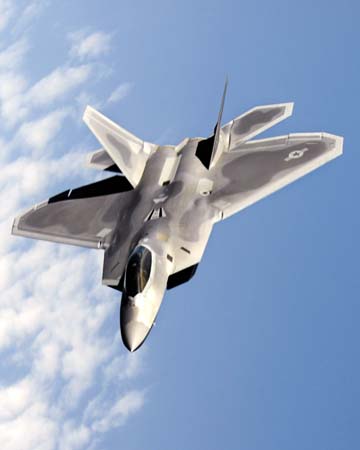The 2010 bu dget proposal announced last month by Defense Secretary Robert Gates carry enormous risks for air superiority, erroneously assuming the F-35 can fill the capability gap left by termination of the F-22 program at 186 aircraft, so said defense experts and former senior Air Force officials at an Air Force Association-sponsored budget discussion Wednesday at the National Press Club. Retired Lt. Gen. Thomas McInerney, a former assistant vice chief of staff, told the audience that with only a total of 186 airframes, the Air Force would be able to field perhaps 100 combat-coded Raptors, when training, depot maintenance, and other considerations are factored in. “That is the smallest air superiority capability for the US since the end of World War I,” McInerney declared. Retired Gen. Richard Hawley, former Air Combat Command boss, said that when requirements were developed for the air superiority fighter that became the F-22 there were three important attributes—super cruise, high altitude operations, and stealth—and it’s the combination of all three—which the F-35 cannot match—that provides the survivability needed against advanced surface-to-air systems. Hawley pointed out that the F-35 has the internal capacity for four air-to-air missiles, which in an air superiority environment would not be adequate. The notion that the F-35 is equivalent reveals a “gross ignorance” of the problem faced in an environment where air dominance is being challenged, he asserted. With such a limited Raptor force, the US will have the capability for air dominance in one theater only.
dget proposal announced last month by Defense Secretary Robert Gates carry enormous risks for air superiority, erroneously assuming the F-35 can fill the capability gap left by termination of the F-22 program at 186 aircraft, so said defense experts and former senior Air Force officials at an Air Force Association-sponsored budget discussion Wednesday at the National Press Club. Retired Lt. Gen. Thomas McInerney, a former assistant vice chief of staff, told the audience that with only a total of 186 airframes, the Air Force would be able to field perhaps 100 combat-coded Raptors, when training, depot maintenance, and other considerations are factored in. “That is the smallest air superiority capability for the US since the end of World War I,” McInerney declared. Retired Gen. Richard Hawley, former Air Combat Command boss, said that when requirements were developed for the air superiority fighter that became the F-22 there were three important attributes—super cruise, high altitude operations, and stealth—and it’s the combination of all three—which the F-35 cannot match—that provides the survivability needed against advanced surface-to-air systems. Hawley pointed out that the F-35 has the internal capacity for four air-to-air missiles, which in an air superiority environment would not be adequate. The notion that the F-35 is equivalent reveals a “gross ignorance” of the problem faced in an environment where air dominance is being challenged, he asserted. With such a limited Raptor force, the US will have the capability for air dominance in one theater only.
President Donald Trump is interested in developing a twin-engined, upgraded version of the F-35 fighter, he said during a press event May 15 in Qatar marking the sale of Boeing airliners and GE Aerospace engines to Qatar Airways. He said he would name the improved aircraft the “F-55” and also…